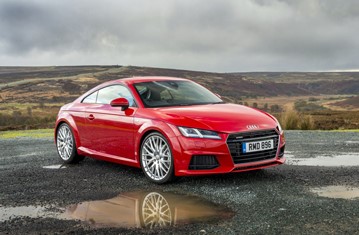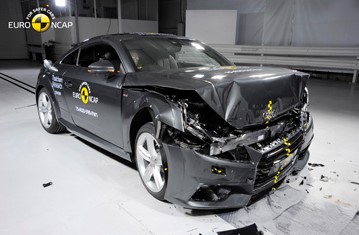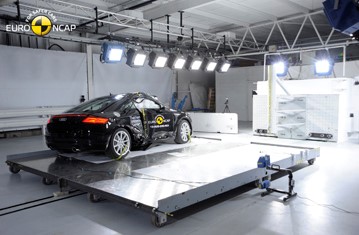Find more information in the General Comments section of the assessment
Find more information in the Rating Validity tab of the assessment
- See More
- See More
- See More
- See More
- Good
- Adequate
- Marginal
- Weak
- Poor
 Passenger
Passenger
 Driver
Driver
 Rear Passenger
Rear Passenger
 Driver
Driver
 Car
Car
 Pole
Pole
 Rear Seat
Rear Seat
 Front Seat
Front Seat
- Good
- Adequate
- Marginal
- Weak
- Poor


Passenger
outboard
Fitted to the vehicle as standard
Not fitted to the test vehicle but available as option
Not Available
-
Infants up to 13 kg
-
Infants and toddlers up to 18 kg
-
Toddlers from 9 to 18 kg
-
Toddlers over 18 kg
Easy
Difficult
Safety critical
Not allowed
| Seat Position | |||
|---|---|---|---|
| Front | 2nd row | ||
| Passenger | Left | Right | |
| Maxi Cosi Cabriofix (Belt) | |||
| Britax Römer King Plus (Belt) | |||
| Britax Römer Duo Plus (ISOFIX) | |||
| Britax Römer KidFix (Belt) | |||
| Maxi Cosi Cabriofix & EasyFix (Belt) | |||
| Maxi Cosi Cabriofix & EasyFix (ISOFIX) | |||
| BeSafe iZi Kid X3 ISOfix (ISOFIX) | |||
| Maxi Cosi Pearl & Familyfix (ISOFIX) | |||
| Britax Römer KidFix (ISOFIX) | |||
Easy
Difficult
Safety critical
Not allowed
There is not sufficient space in the rear seats to use Audi's recommended child restraints when the front seats are in the positions needed to assess adult occupant protection. Separate tests were conducted, with the front seats moved forward, to establish the protection provided to children. Based on those dynamic tests results, the TT scored maximum points for its protection of the 3 year dummy. Both dummies were seated in rearward-facing restraints and, in the side impact, both were properly contained within the protective shells of the restraints, minimising the risk of head contact with parts of the vehicle interior. The front passenger airbag can be disabled to allow a rearward-facing child restraint to be used in that seating position. The rear seats cannot accommodate several categories of child restraint as the upright seating position does not allow for a stable installation.
- Good
- Adequate
- Marginal
- Weak
- Poor

Head Impact 17.7 Pts
Pelvis Impact 6.0 Pts
Leg Impact 6.0 Pts
The TT has an 'active' bonnet. Sensors detect when a pedestrian has been struck and actuators lift the bonnet, creating more space between the bonnet surface and the hard structures underneath. Audi showed that the system worked for a broad range of speeds and for many pedestrian statures so the car was tested with the bonnet in the deployed (raised) position. The protection provided to the head of a struck pedestrian was almost entirely good or adequate, with some marginal and poor results recorded on the bonnet edges and the stiff windscreen pillars. The protection provided to pedestrian's legs by the bumper was good in all areas tested, as was that provided by the front edge of the bonnet, both of these areas scoring maximum points in Euro NCAP's tests.
- Good
- Adequate
- Marginal
- Weak
- Poor
| Speed Limit Information Function | N/A |
| Warning Function | Manually set |
| Speed Limitation Function | Manually set |
| System Name | ESC | |
| Performance | ||
| Vehicle Yaw Rate @ COS + 1.00 s | 1.4% | meets ECE requirements |
| Vehicle Yaw Rate @ COS + 1.75 s | 1.6% | meets ECE requirements |
| Lateral Displacement @ BOS + 1.07 s | 3.62 m | meets ECE requirements |
| Applies To | All seats | ||
| Warning | Driver Seat | Front Passenger(s) | Rear Passenger(s) |
| Visual | |||
| Audible | |||
|
|||
| System Name | Audi active lane assist |
| Type | Lane keep assist |
| Operational From | 65 km/h |
| Warning | Visual |
| Performance | |
|
LDW Confirmation Test
|
Pass |
The TT has electronic stability control as standard equipment, together with a seatbelt reminder system for the front and rear seats. A driver-set speed limitation device is an option but is expected to be fitted to most vehicles sold so it was included in the assessment and met Euro NCAP's requirements for systems of this type. A lane departure warning system is also an option that was tested and fulfilled the requirements. An autonomous emergency braking system is not currently available on the TT.
- Specifications
- Safety Equipment
- Videos
- Advanced Rewards
- Rating Validity
Specifications
Tested Model Audi TT 2.0TFSI 'Sport', FWD, RHD
Body Type - 3 door hatchback
Year Of Publication 2015
Kerb Weight 1230kg
VIN From Which Rating Applies - all TT's of the specification tested
Class Roadster sports
Safety Equipment
Note: Other equipment may be available on the vehicle but was not considered in the test year.
Fitted to the vehicle as standard
Fitted to the vehicle as option
Not fitted to the test vehicle but available as option
Not Available
Not Applicable
Videos
Advanced Rewards
Rating Validity







Find more information in the General Comments section of the assessment
 Share
Share











The passenger compartment of the TT remained stable in the offset deformable barrier impact. Dummy readings indicated good protection of the knees and femurs of the driver and passenger dummies. Audi showed that a similar level of protection would be provided to occupants of different sizes and to those sat in different positions. In the full-width frontal impact (new for 2015), protection for the small female in the driver's seat was good for all body areas except the chest, protection of which was adequate. Audi showed that a very similar level of protection would be provided for the same size of occupant in the front passenger seat. Although Audi does not recommend the use of the rear seats for persons taller than 1.45m for safety reasons, Euro NCAP used the 1.50m small female dummy in the rear, passenger-side seat, in keeping with its protocols. The test car, sourced in the UK, was equipped with rear seatbelt pre-tensioners, although this is not standard equipment everywhere in Europe. In the test, the head of the dummy contacted the rear of the front passenger seat, but injury values were low and protection was rated as good. Protection of the neck was adequate while measurements of chest compression indicated a marginal level of protection for this part of the body. In the side barrier test, the TT scored maximum points, with good protection of all parts of the body. Even in the more severe side pole impact, the TT provided good protection to all parts of the dummy and scored full points. Euro NCAP tested the variant that is currently available in the UK, fitted with non-standard alcantara seats. Those front seats provided good protection against whiplash injury in the event of a rear-end collision but a geometric assessment of the rear seats indicated poor whiplash protection. The TT does not have a low-speed autonomous braking system.